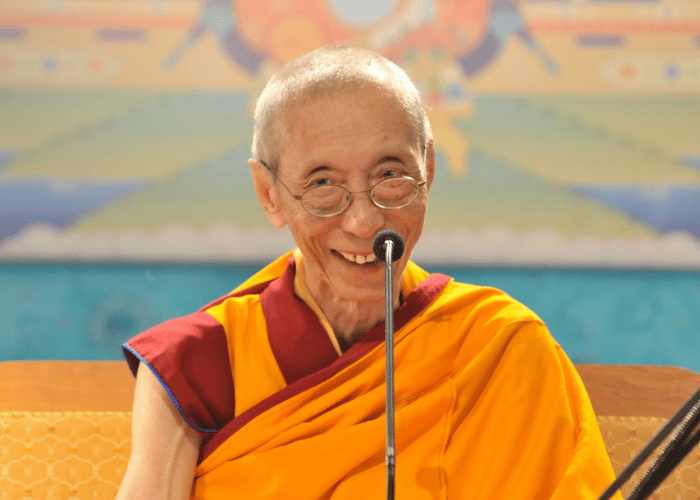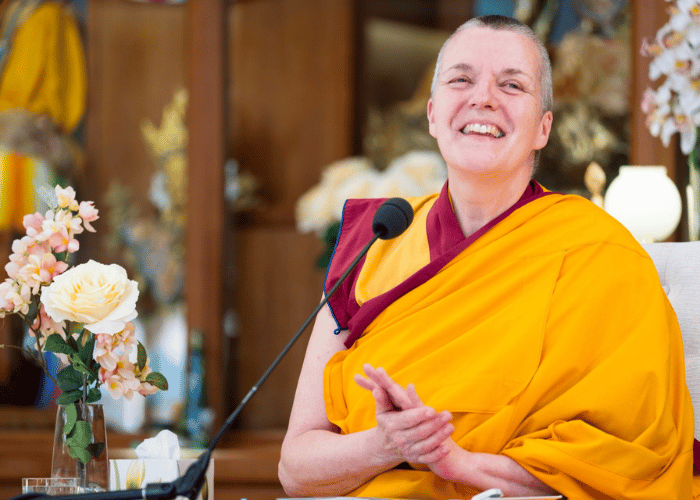Our Teachers & Tradition

Our Founder
Venerable Geshe Kelsang Gyatso is the Founder of the New Kadampa Tradition and is a fully accomplished meditation master and internationally renowned teacher of Buddhism. Geshe-la, as he is affectionately called by his students, is primarily responsible for the worldwide revival of Kadampa Buddhism in our time.
From the age of eight Geshe-la studied extensively in the great monastic universities of Tibet and earned the title Geshe, which literally means spiritual friend. Under the guidance of Trijang Rinpoche, his Spiritual Guide, he then spent the next eighteen years in meditation retreats in the Himalayas.
Teaching in the West
In 1977 he accepted an invitation to teach at Manjushri Kadampa Meditation Centre in England, where he lived for many years giving teachings and guidance to an ever-growing group of disciples.
Geshe-la continued to teach on Kadampa Buddhism in many countries around the world until his retirement in 2009, and has published a series of remarkable books on Buddhist thought and meditation. Right up until his death, he continued to work tirelessly for the benefit of others.
During the course of his remarkable life, he established three unique study programmes and over 200 meditation centres around the world, trained qualified teachers and a flourishing ordained community, and created a project to build Buddhist temples in every major city in the world.
Teaching from example
In his teachings, Geshe Kelsang emphasised the importance of meditation and how to apply it in daily life, the need to be truly happy, and how to cultivate a good heart to help others, and he demonstrated these qualities perfectly in his own life. This remarkable teacher inspired so many people from so many different countries because he taught by example.

General Spiritual Director
The elected General Spiritual Director of the New Kadampa Tradition is Gen-la Kelsang Dekyong. She lives at the mother centre of the NKT, Manjushri Kadampa Meditation Centre in Cumbria, and teaches at Buddhist festivals and celebrations around the world.
International Festivals
Every year, three International Festivals of teachings, empowerments and meditations brings the Kadampa family together from around the world.

FAQs
The New Kadampa Tradition – International Kadampa Buddhist Union (NKT-IKBU) is a global Buddhist community founded in 1991 by Venerable Geshe Kelsang Gyatso Rinpoche. Its aim is to uphold and make available the authentic teachings of Kadampa Buddhism for the benefit of all.
Rooted in the teachings of Buddha Shakyamuni as passed down from the great Buddhist masters Atisha and Je Tsongkhapa, Geshe Kelsang Gyatso has made the timeless wisdom of Buddha's teachings accessible to people everywhere.
Through its international network of affiliated centers and community-based initiatives, the NKT shares the practical benefits of these teachings with people of all backgrounds and walks of life.
The New Kadampa Tradition is an independent Buddhist tradition with no political affiliations. Legally registered as a non-profit charitable organization in England under the name New Kadampa Tradition – International Kadampa Buddhist Union (NKT-IKBU).
The NKT main office is located at Manjushri Kadampa Meditation Center in Ulverston, UK, which is the Mother Center of the New Kadampa Tradition – International Kadampa Buddhist Union.
Being a Buddhist means taking refuge in the Three Jewels–Buddha, Dharma, and Sangha—as the true and reliable protection from suffering. Going for refuge is the foundation of the Buddhist path and the essential step that marks the beginning of someone’s life as a Buddhist.
Going for refuge means developing heartfelt trust in:
- Buddha as our guide and perfect example
- Dharma (Buddha’s teachings and our own inner experience of them) as the actual protection from suffering
- Sangha (the spiritual community) as our companions and support on the path
In the NKT, we train in this inner refuge by learning to turn inward for solutions to our problems, relying on the wisdom and methods taught by Buddha to transform our mind. We gradually let go of external objects or conditions as our main source of happiness or protection, and instead turn to Dharma practice to find real peace and freedom.
For those who wish to formally become Buddhist, there is the opportunity to take the Refuge Vow—a beautiful and meaningful ceremony in which one makes a conscious decision to rely on the Three Jewels and commit to living in accordance with Buddhist principles. This vow marks the beginning of a new life, one based on spiritual practice, ethical conduct, and the intention to progress toward liberation and enlightenment for the benefit of all beings.
The New Kadampa Tradition is a modern presentation of Kadampa Buddhism that includes the Hinayana, Mahayana and Vajrayana paths. They are rooted in the teachings of Buddha and the great Indian and Tibetan masters such as Atisha and Je Tsongkhapa.
All practices are grounded in love and compassion for all living beings. With the guidance of Venerable Geshe Kelsang Gyatso Rinpoche, these teachings are presented in a way that speaks to modern people — clear, accessible, and relevant to the pace and problems of contemporary life.
The three key teachings are:
- Lamrim, or “Stages of the Path to Enlightenment.” This practical, step-by-step guide takes us from the basics of developing a kind heart, through cultivating deep wisdom all the way to the attainment of enlightenment to benefit all living beings.
- Lojong, or “Training the Mind.” These teachings show how we can use everyday difficulties as opportunities to grow stronger spiritually, developing greater patience, compassion, and wisdom—and learning to keep a calm and positive mind, whatever life brings.
- Mahamudra. According to Sutra, this refers to the profound view of emptiness. A direct realization of emptiness enables us to accomplish complete liberation from the sufferings of samsara. According to Tantra, or Vajrayana, Mahamudra is the union of spontaneous great bliss and emptiness through which we can attain full enlightenment.
In the New Kadampa Tradition, practitioners rely principally upon four enlightened beings, known as the Four Kadampa Deities.
Buddha Shakyamuni – the founder of Buddhism. Buddha Shakyamuni is the principal object of refuge for all Buddhists.
Avalokiteshvara – the Buddha of Compassion. By relying upon Avalokiteshvara we naturally increase our own compassion.
Green Tara – the female Buddha of wisdom and compassion. Kadampas rely on her especially in times of difficulty and for quick help in removing obstacles.
Dorje Shugden – the Wisdom Dharma Protector for modern Kadampas, who helps, guides and protects sincere practitioners from inner and outer obstacles by granting blessings, increasing their wisdom and fulfilling their virtuous wishes.
Through relying on these four Deities, Kadampa practitioners emphasize the essential practices of Kadampa Buddhism that enable them to gain pure Dharma realizations and make progress on the spiritual path.
All Buddha’s teachings help to improve our mental well being and happiness. However, we are not mental health experts and always recommend people with mental health problems to seek help from professional medical health practitioners.
Although there are healing practices taught within Kadampa Buddhism, those suffering from physical illness are always advised to seek medical attention.
As a tradition, the focus is on operating independently, without political affiliations or ties to specific cultural, national, or ideological identities. Emphasis is placed on pure spiritual practice, free from worldly concerns.
The New Kadampa Tradition (NKT) holds a respectful and inclusive view towards other religions.
As explained in Modern Buddhism by Venerable Geshe Kelsang Gyatso, the founder of the NKT, there are many different forms of Buddhism–such as Zen, Theravāda, and others–and all are regarded as equally precious. Though their presentations may differ, they are all pure lineages of Buddha’s teachings, and suited to the needs and dispositions of different people.
This spirit of respect also extends beyond Buddhism. The NKT respects any religion that teaches a path to true happiness.
The New Kadampa Tradition (NKT) takes complaints of misconduct seriously and follows a comprehensive Safeguarding Policy and Procedures, adopted in 2018. This policy applies to all individuals in positions of responsibility within the tradition, including teachers, staff, and volunteers.
The policy aims to protect everyone–especially children and adults-at-risk–and reflects the NKT’s commitment to maintaining a pure, peaceful, and respectful environment.
